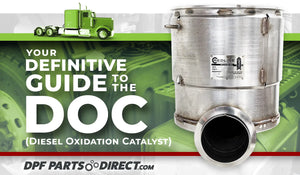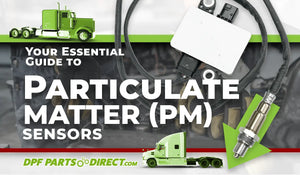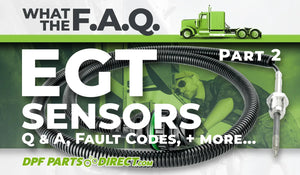1. What is a PM Sensor, and Where Does it Live?
A Particulate Matter (PM) sensor is a sophisticated electronic device designed to monitor the concentration of fine soot and ash particles within a truck's exhaust system. These particles are natural byproducts of the combustion process in diesel engines. It plays a pivotal role in ensuring the vehicle adheres to emission standards and assists the engine's control unit (ECU) in managing the Diesel Particulate Filter (DPF) system.
Typical Location:
The PM sensor is typically installed downstream of the DPF and at the outlet of the Selective Catalytic Reduction (SCR) system. This strategic placement means that if the aftertreatment system is working correctly, virtually no particulate matter should reach the sensor. If it detects particles, it signals a potential issue upstream, making it a key diagnostic tool for the entire aftertreatment system.
2. How Your PM Sensor Actually Works
Most PM sensors in heavy-duty trucks operate on a **resistance measurement** principle. They have interdigital comb-like electrodes where soot particles deposit. As soot accumulates, it creates conductive pathways, decreasing electrical resistance.
The Process:
- Soot particles from exhaust gas deposit on sensor electrodes.
- Accumulated soot forms conductive pathways.
- Electrical resistance across the sensor decreases.
- When conductivity reaches a threshold, a signal is sent to the ECU.
- ECU initiates DPF regeneration to burn off trapped soot.
- Sensor element heats up (often >600°C ) to burn off its own deposited soot, resetting for the next measurement.
>600°C
Sensor Self-Cleaning Temperature
Ensures accurate subsequent measurements by burning off deposited soot from the sensor element.
The PM sensor is a "smart sensor," communicating with the ECU via a CAN (Controller Area Network) interface. It detects a pre-set soot threshold to trigger DPF regeneration, rather than providing a continuous mass concentration. This makes its own regeneration cycle crucial for accurate ongoing operation. It also helps monitor for DPF substrate failures like cracks or melting.
3. Handling and Installing PM Sensors: Do's and Don'ts
Proper handling and installation are critical for PM sensor longevity and accuracy. These are delicate components.
Do:
- ✔️ Handle with extreme care (fragile ceramic element).
- ✔️ Keep protective cap on until installation.
- ✔️ Ensure proper orientation (e.g., "3 o'clock position" for some One-Box SCRs).
- ✔️ Use a specialized 22mm Oxygen Sensor socket for removal to protect the harness.
- ✔️ Torque to manufacturer specs (e.g., 50 Nm ± 5 Nm).
- ✔️ If bung threads are damaged, replace the bung (sensor boss).
- ✔️ Check for water damage if multiple failures occur.
Don't:
- ❌ Drop the sensor.
- ❌ Install if it rattles (indicates internal damage).
- ❌ Use any lubricant on sensor threads or tip.
- ❌ Cut the wiring harness during removal.
Adhering to these guidelines reduces premature failures. For example, improper removal leading to bung damage on a One-Box SCR might require removing the entire SCR unit for repair—a costly and time-consuming job.
4. The Big Payoff: Benefits of a Healthy PM Sensor
Maintaining your truck's PM sensor isn't just about compliance; it's about efficiency and savings.
Cleaner Emissions
99%
Reduction in harmful particulate matter.
Crucial for meeting environmental regulations.
Regulatory Compliance
$45,268
Potential fine per non-compliant vehicle.
Avoid costly penalties and ensure legal operation.
Improved Fuel Efficiency
Optimized DPF regeneration cycles mean the DPF regenerates only when necessary, reducing fuel waste from over-regeneration.
Lower Maintenance Costs
Condition-based DPF servicing and minimized high-temp regenerations extend component life and reduce unnecessary cleaning expenses.
Increased Uptime
Prevents DPF clogging and related issues that can lead to derates or breakdowns, minimizing unplanned downtime and lost revenue.
Extended Component Life
Accurate data helps protect the DPF from damage due to incorrect soot estimation, safeguarding expensive aftertreatment parts.
5. Decoding PM Sensor Fault Codes
A PM sensor fault code doesn't always mean the sensor is bad. It often reports issues elsewhere. Always troubleshoot thoroughly!

For codes like P103400, P24D000, U02A300, and P1033, focus on wiring and power first; the sensor is rarely the culprit. For heater codes like P24FC00, check the heater circuit thoroughly. For codes suggesting internal issues (P103100, etc.), verify DPF health before replacing the sensor, and always update ECM software after replacement.
Download your own Quick Reference Guide to Common PM Sensor Fault Codes to save or print.
6. Keeping Your PM Sensor Healthy: Maintenance Tips
Proactive care extends sensor life and ensures efficiency.
-
Routine Inspections & Monitoring
Regularly check sensor, wiring, and connectors for damage/corrosion. Review diagnostic data for atypical readings or fault codes.
-
Address Root Causes of Soot Buildup
Maintain the engine and DPF system. Ensure effective DPF regeneration. Promptly address DPF-related codes.
-
Protect from Environmental Factors
Shield sensor and connections from excessive water. Protect wiring from physical damage, abrasions, or excessive heat.
-
Cleaning (Caution!)
Direct cleaning of the exhaust PM sensor element is generally NOT recommended due to its fragility and self-regenerating design. Soot issues often point to DPF problems.
-
Proper Storage
If storing a sensor, keep it in a sealed container to protect it from dust, insects, and moisture.
-
When to Replace & ECM Update
If issues persist after troubleshooting or readings are erratic, replacement may be needed. Use OEM/high-quality parts. Crucially, update ECM software after sensor replacement for proper calibration.










Comments 0